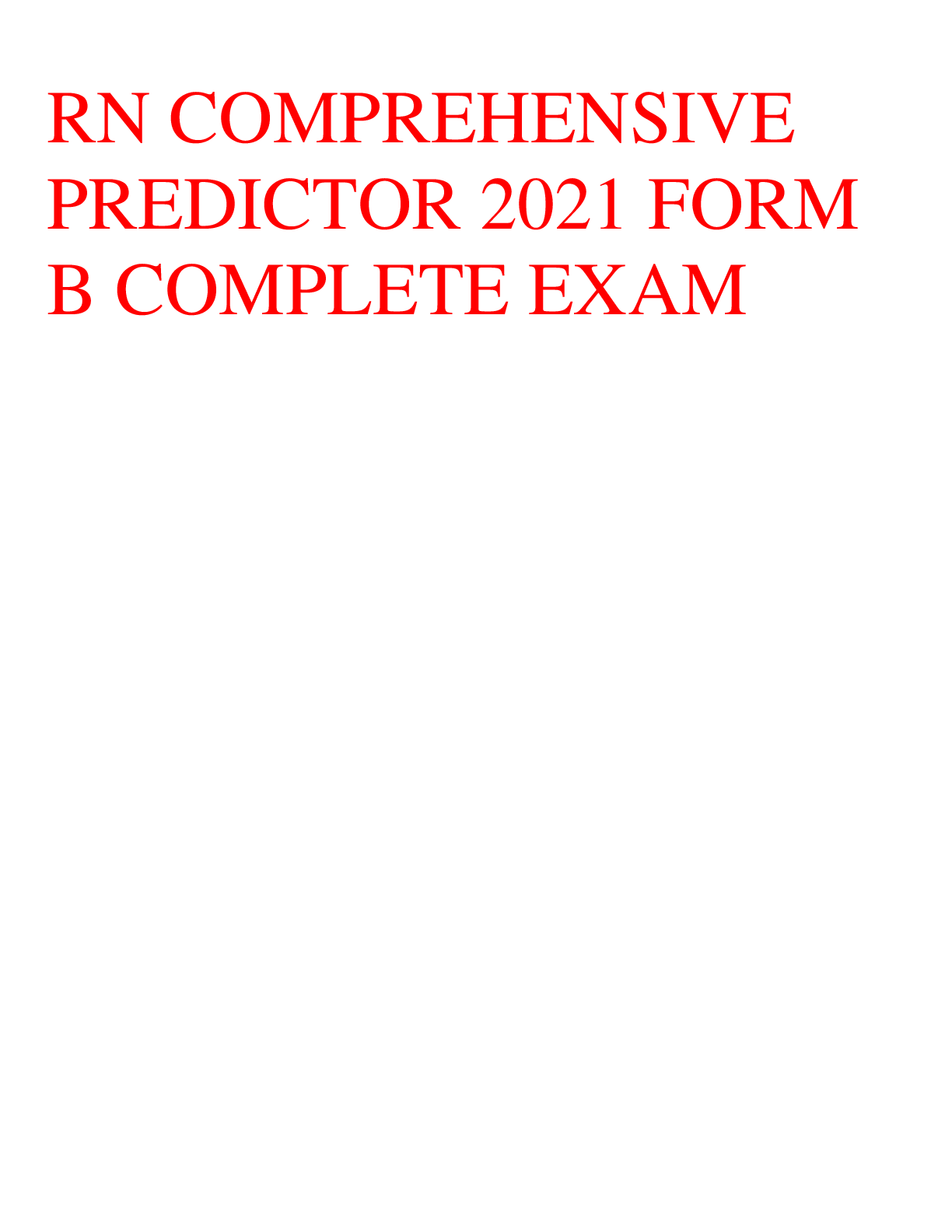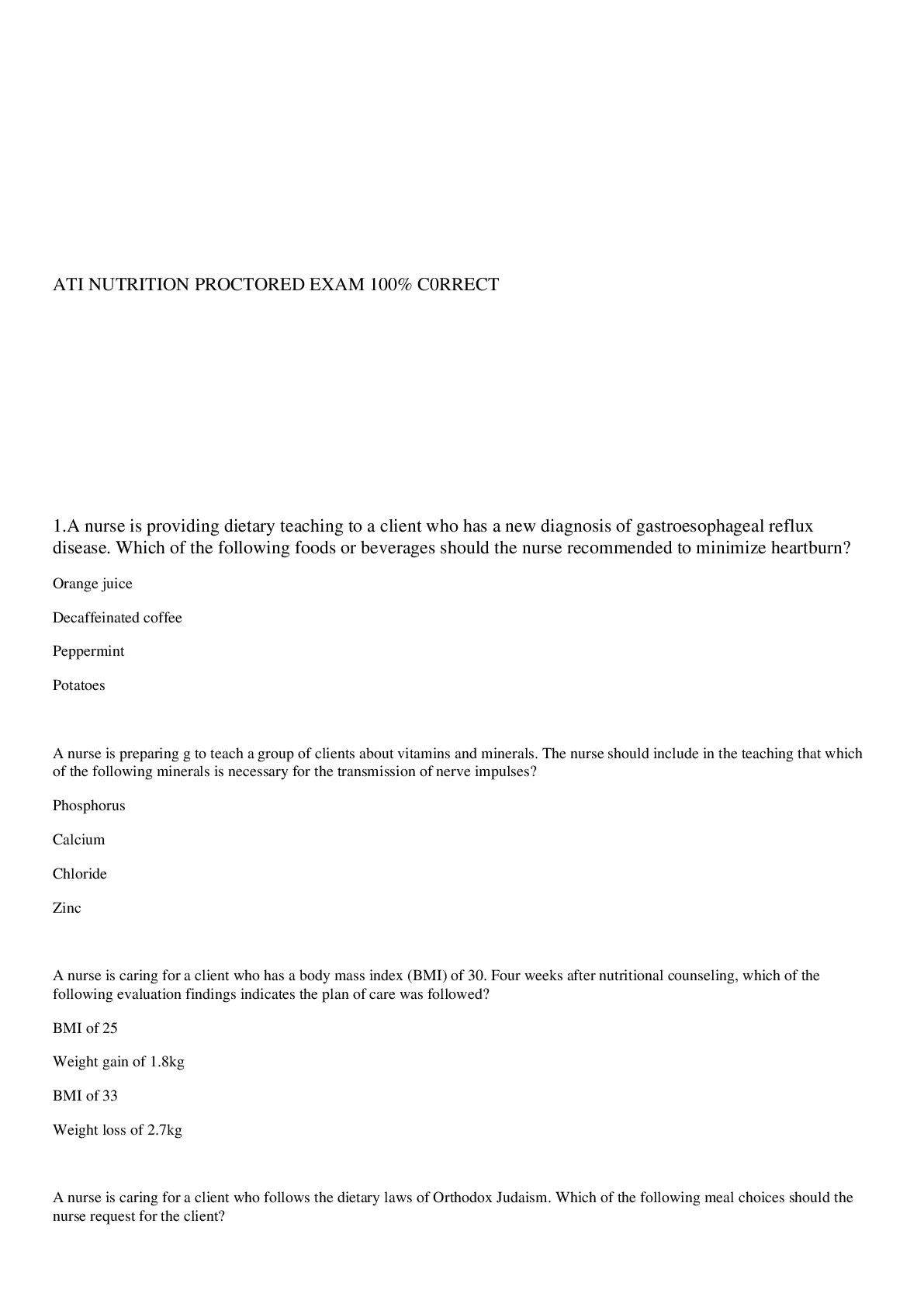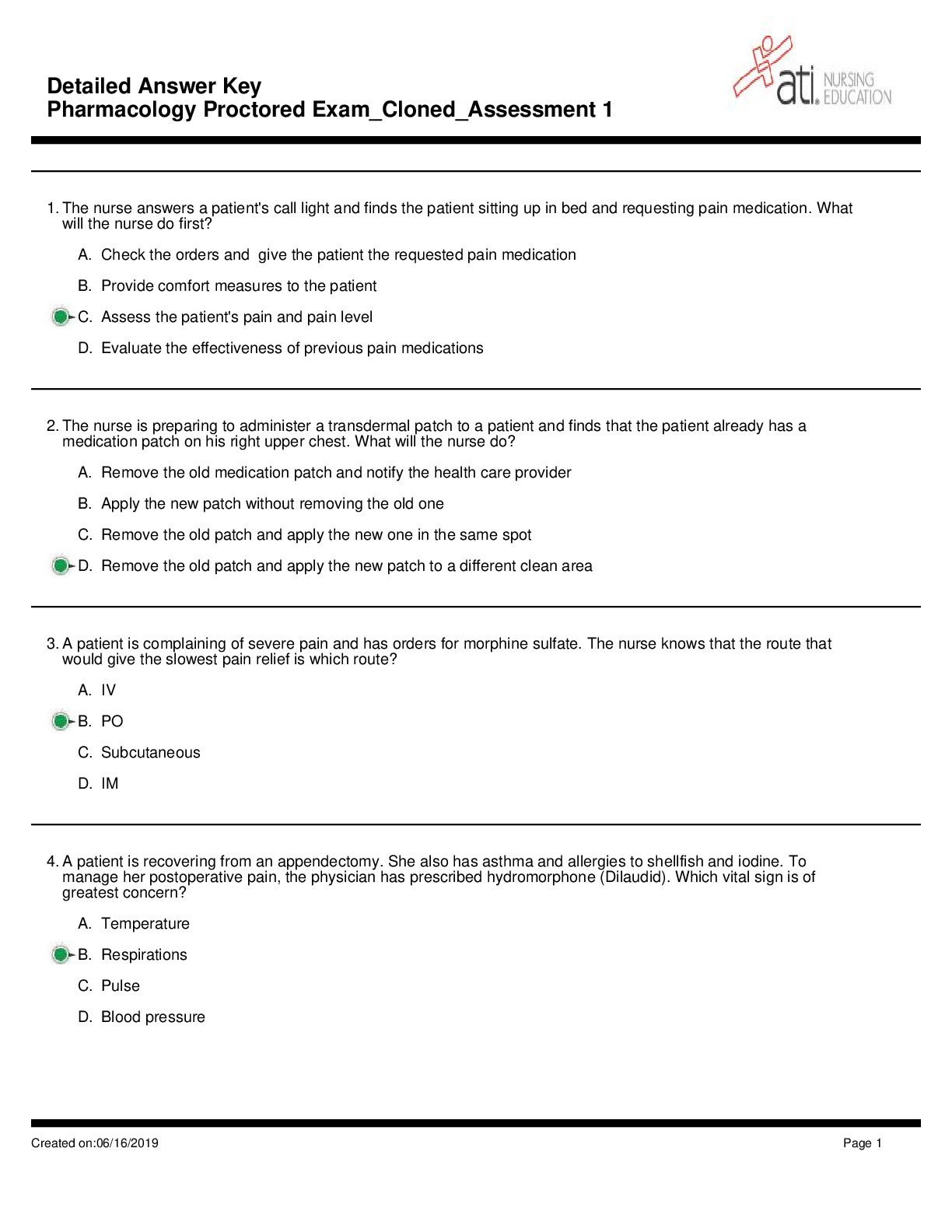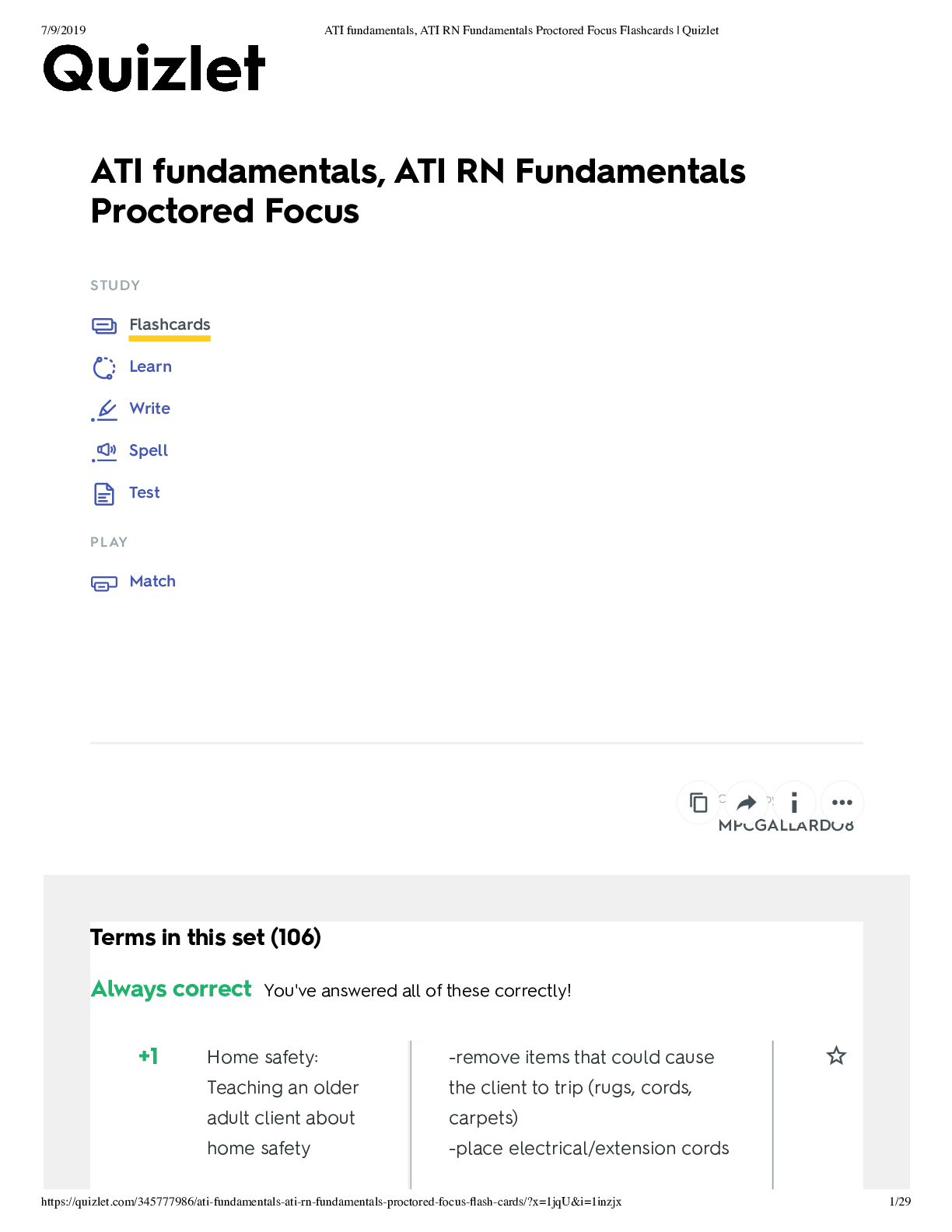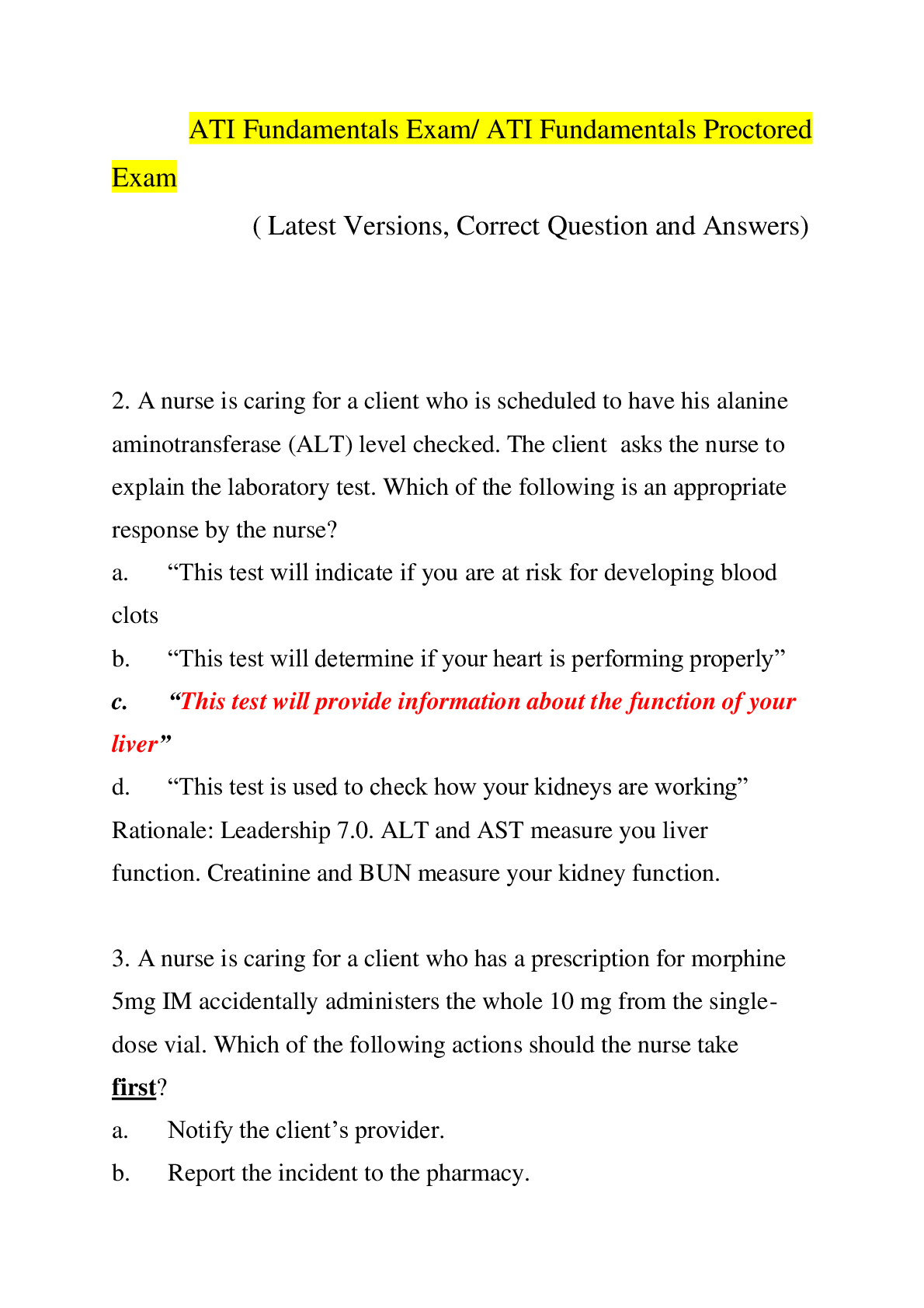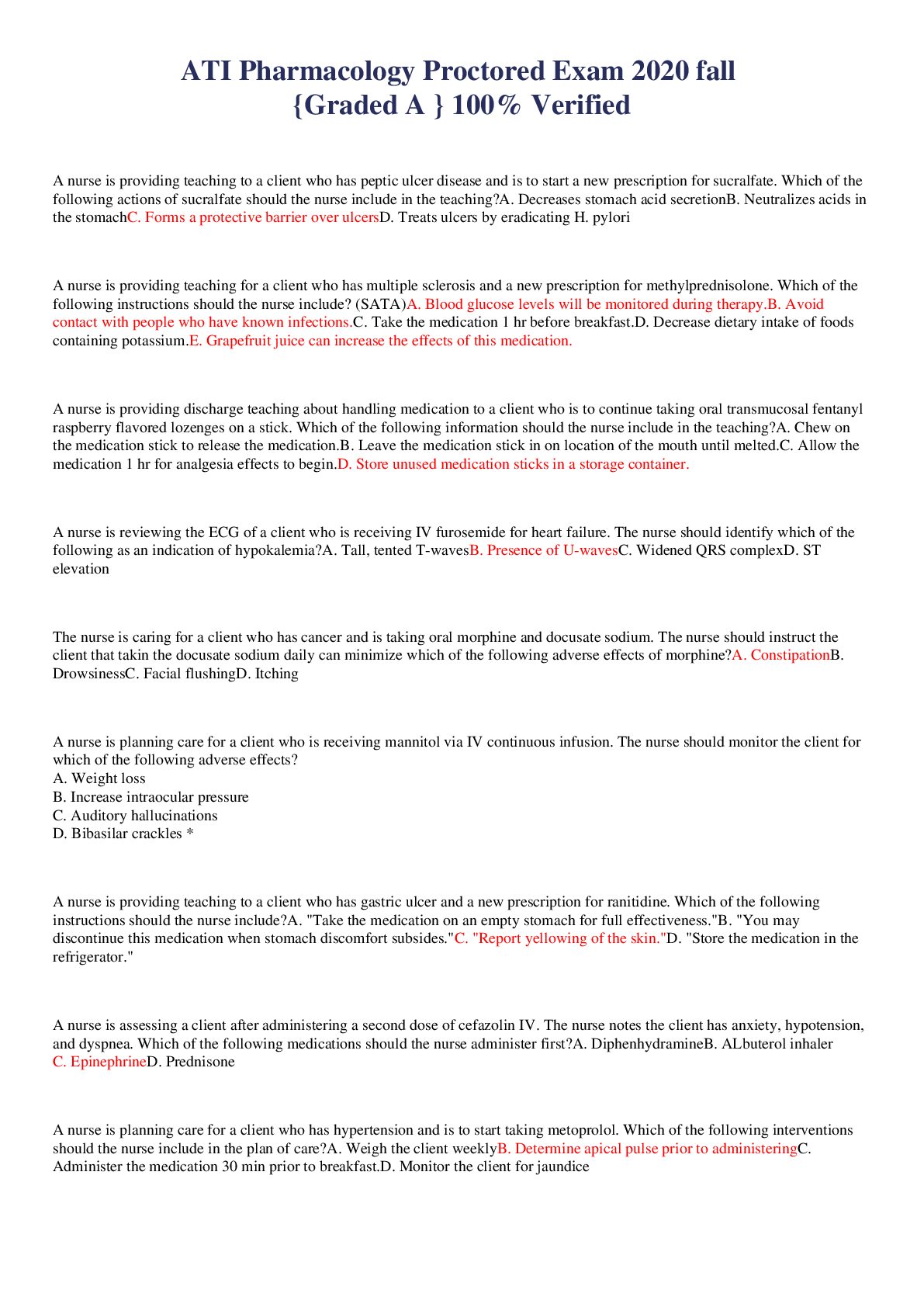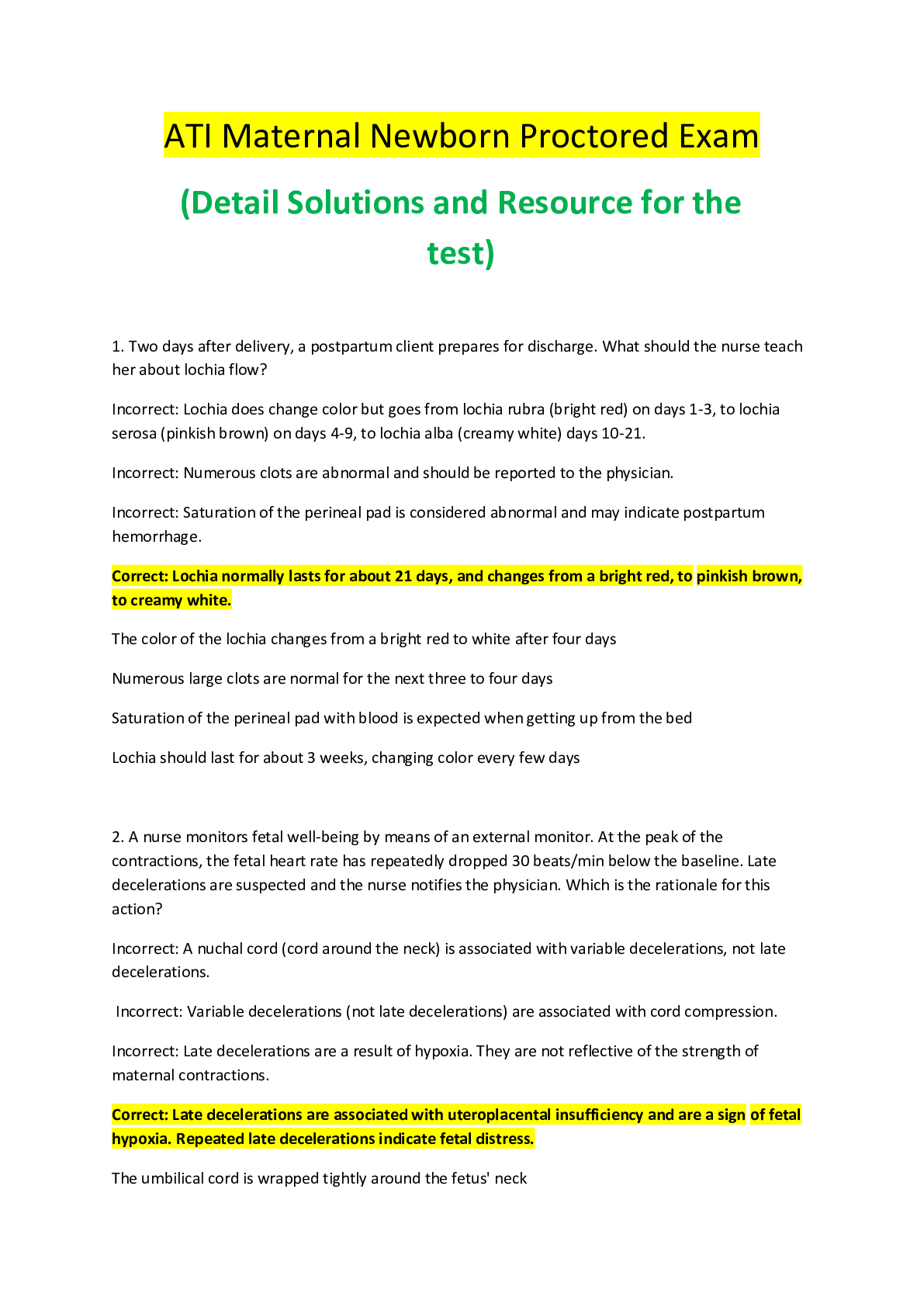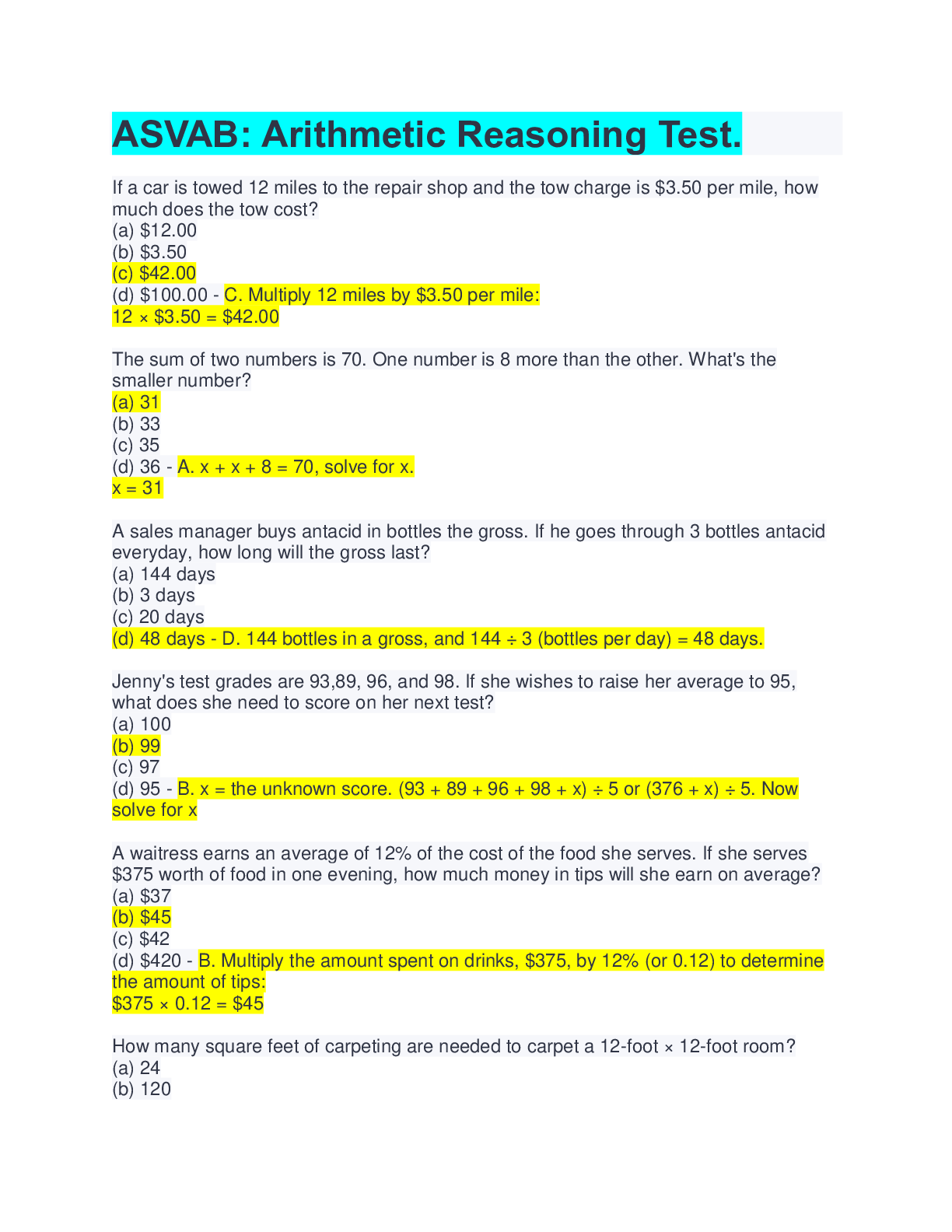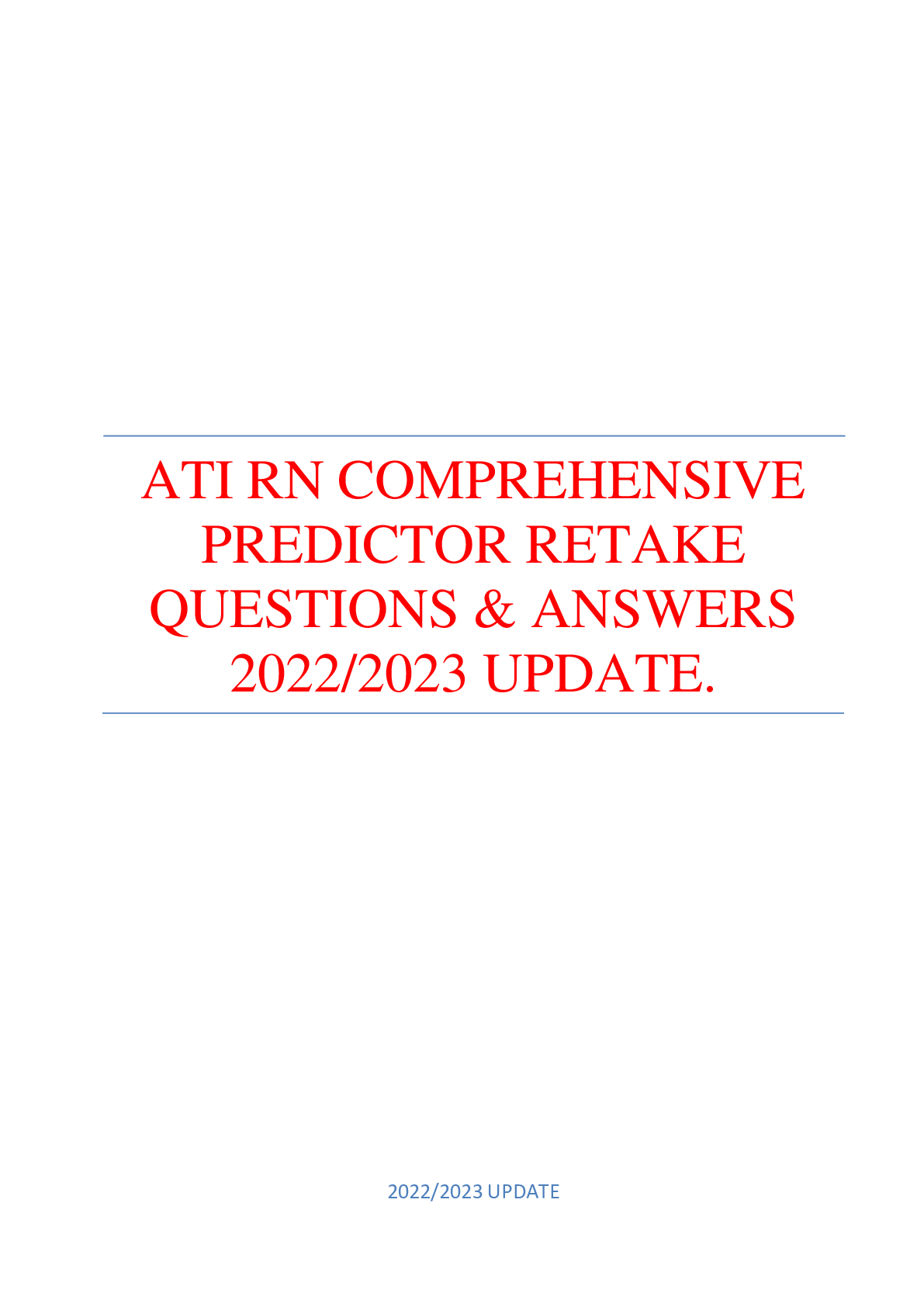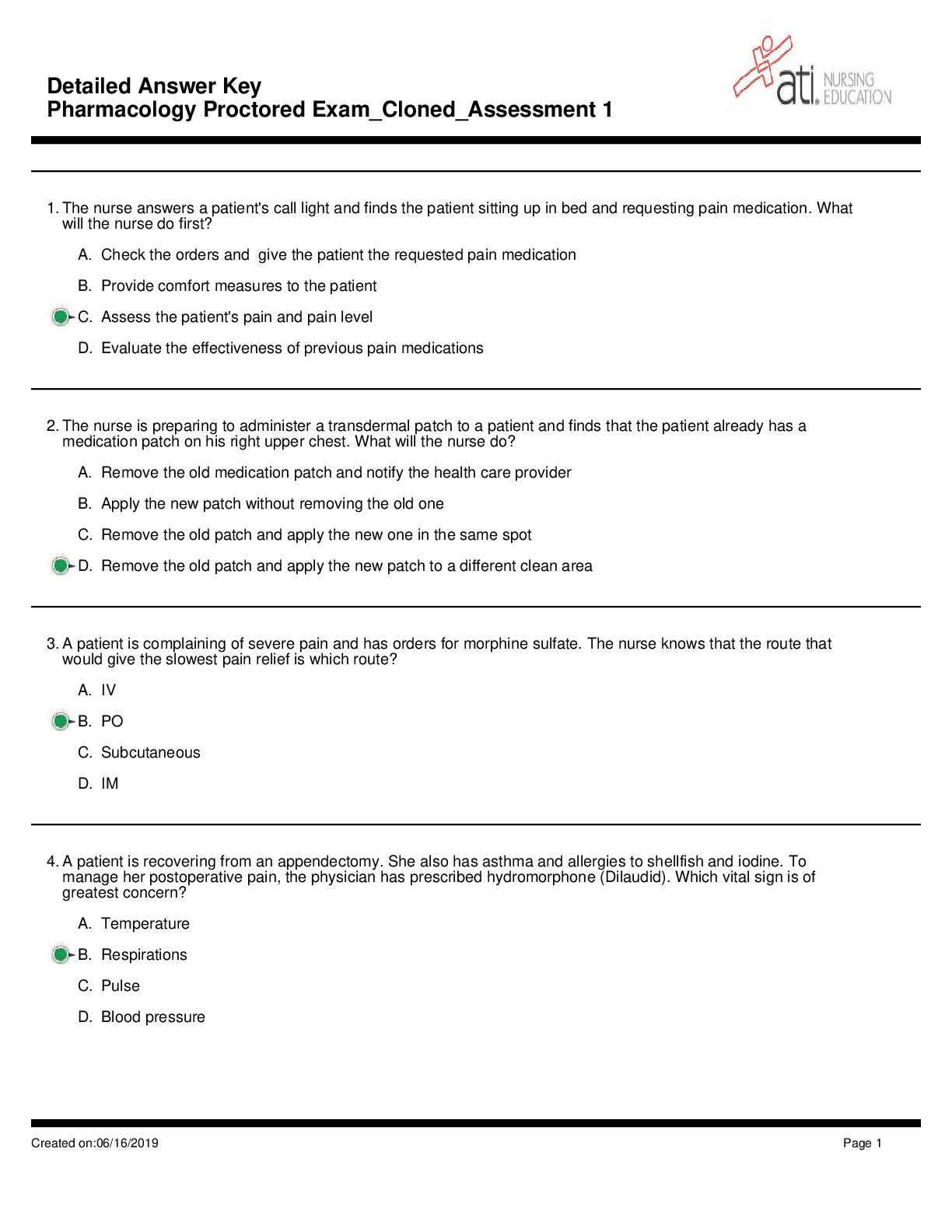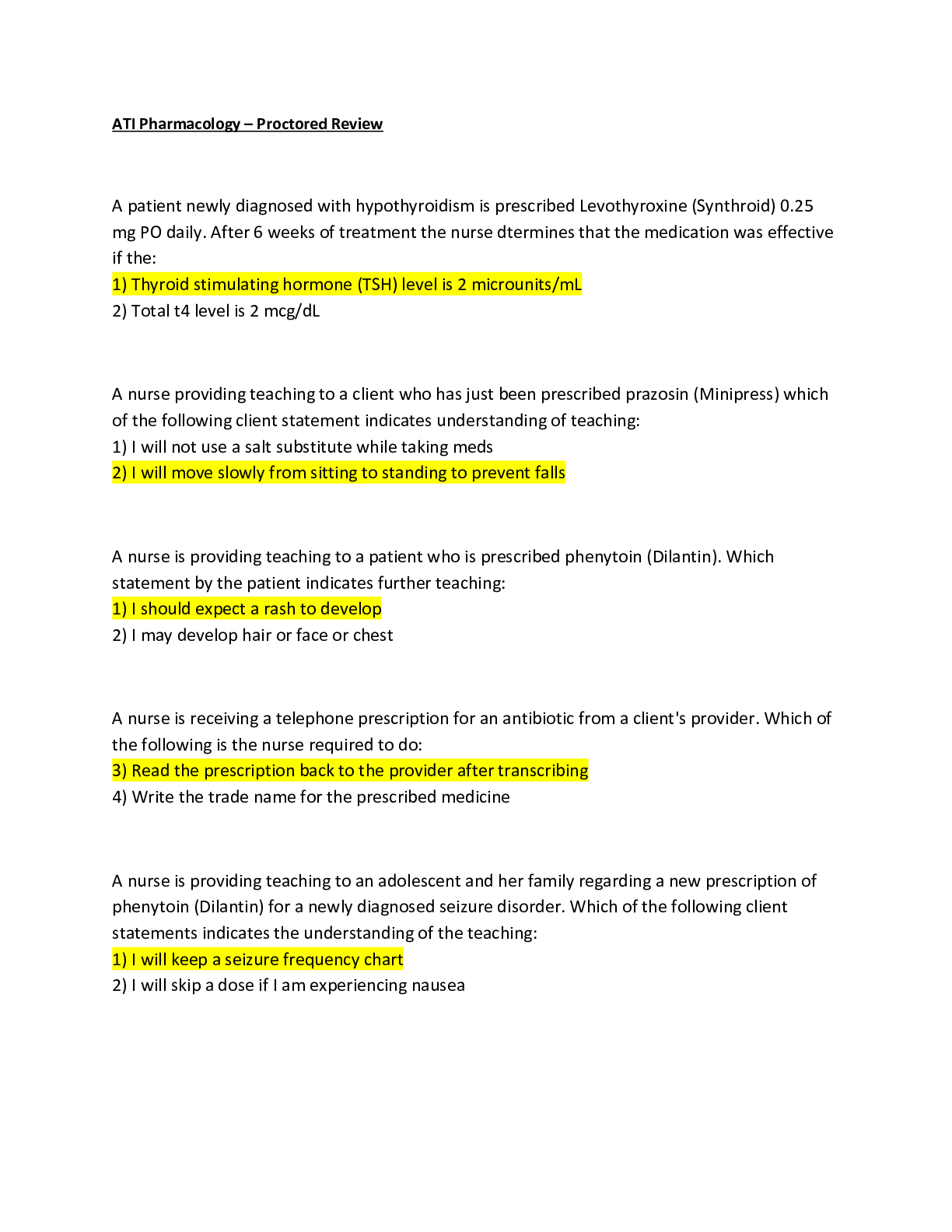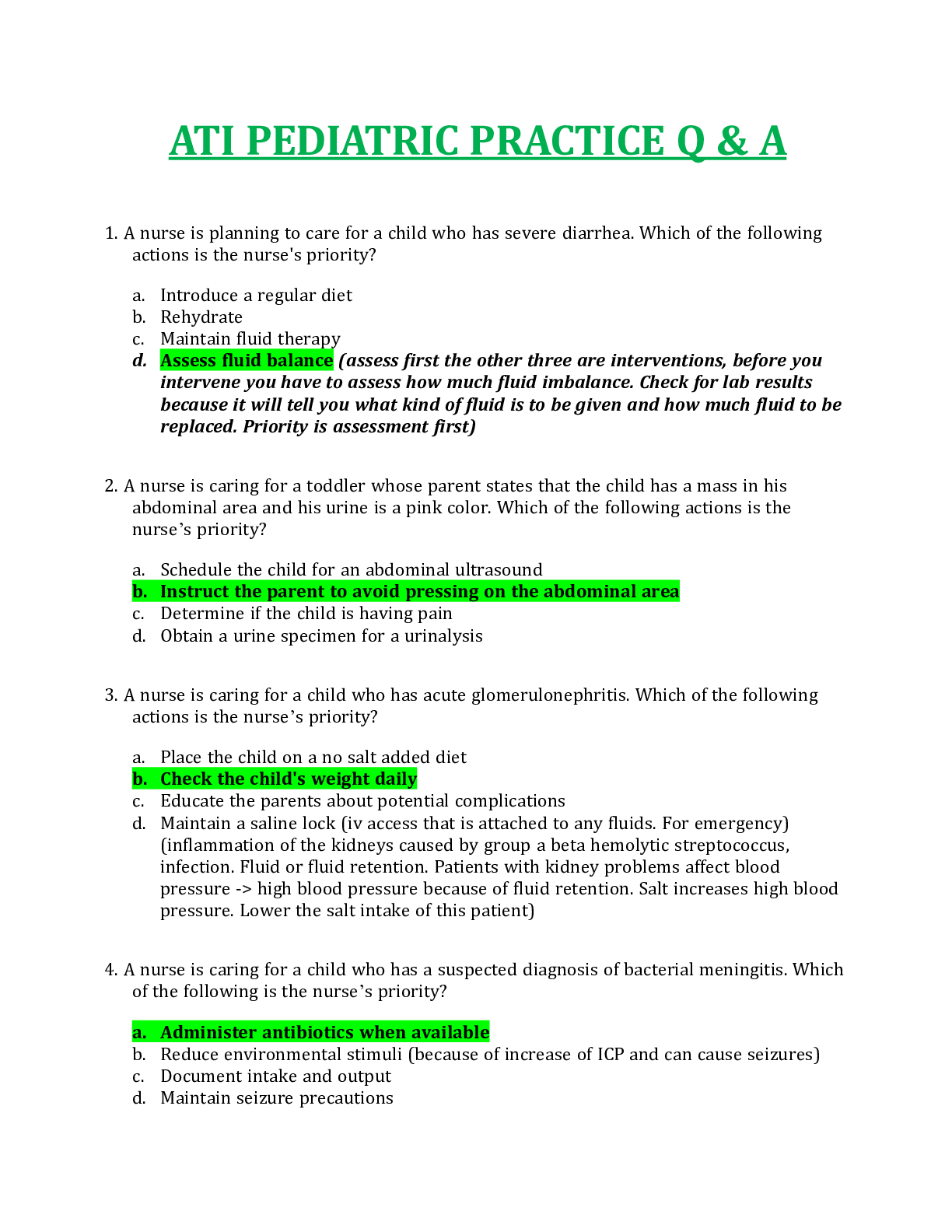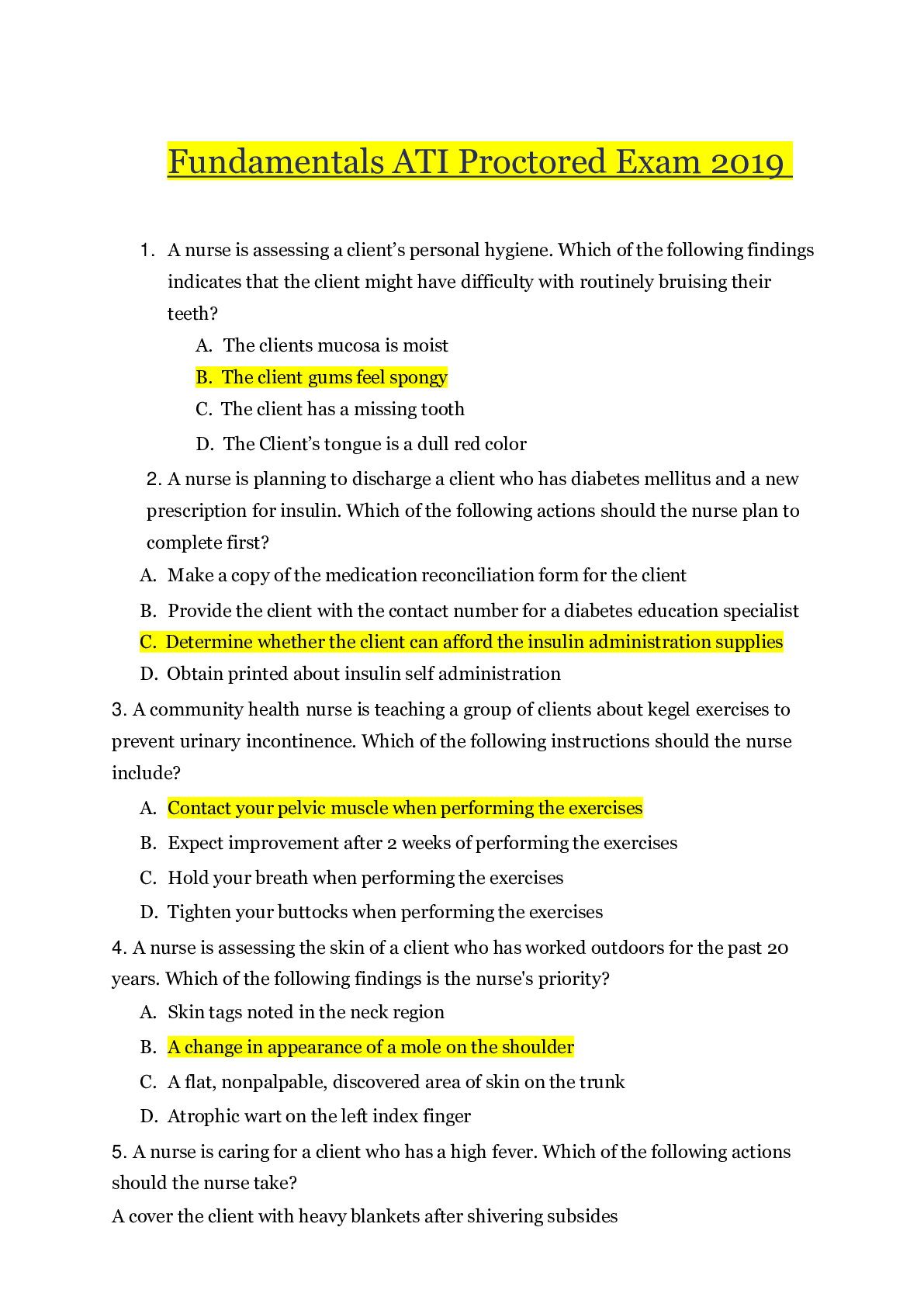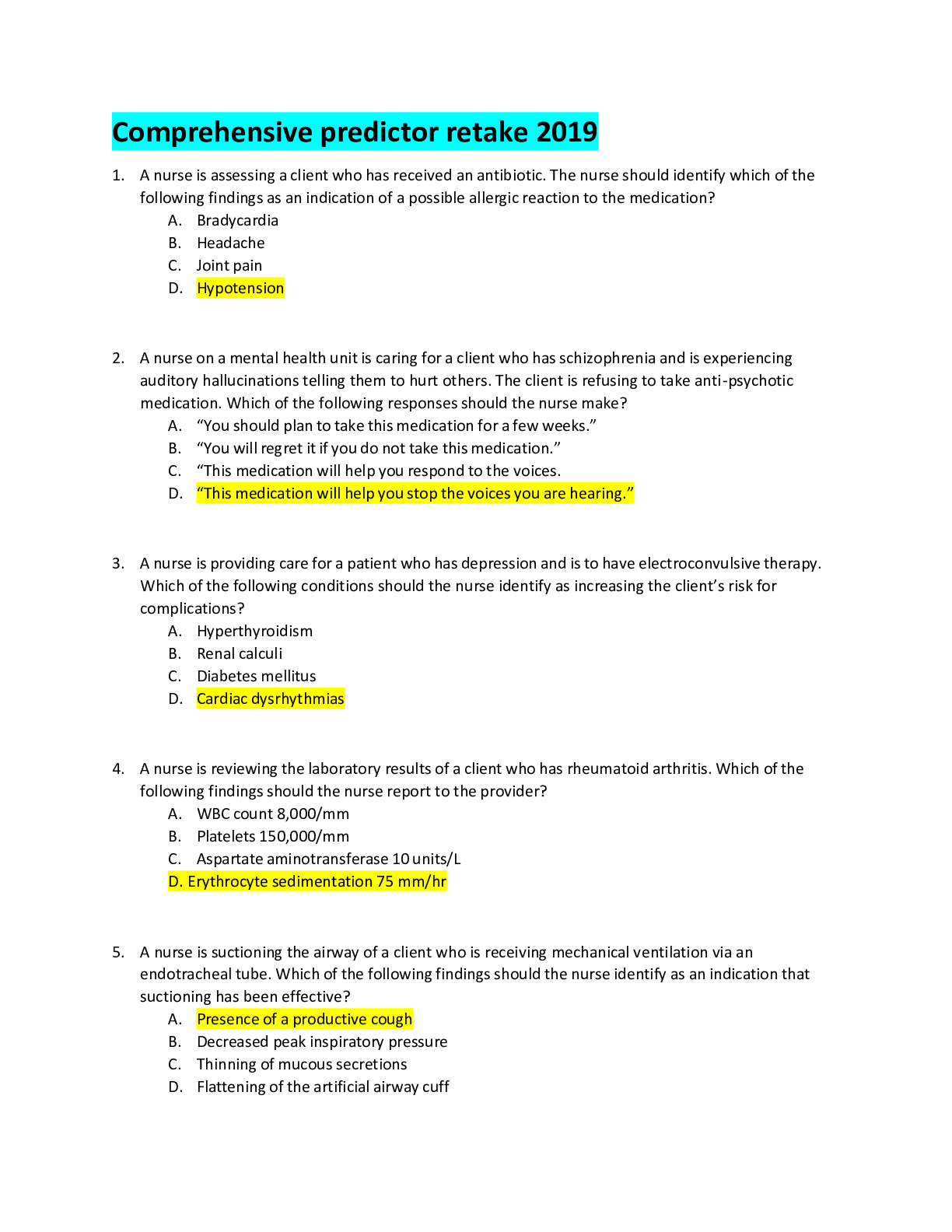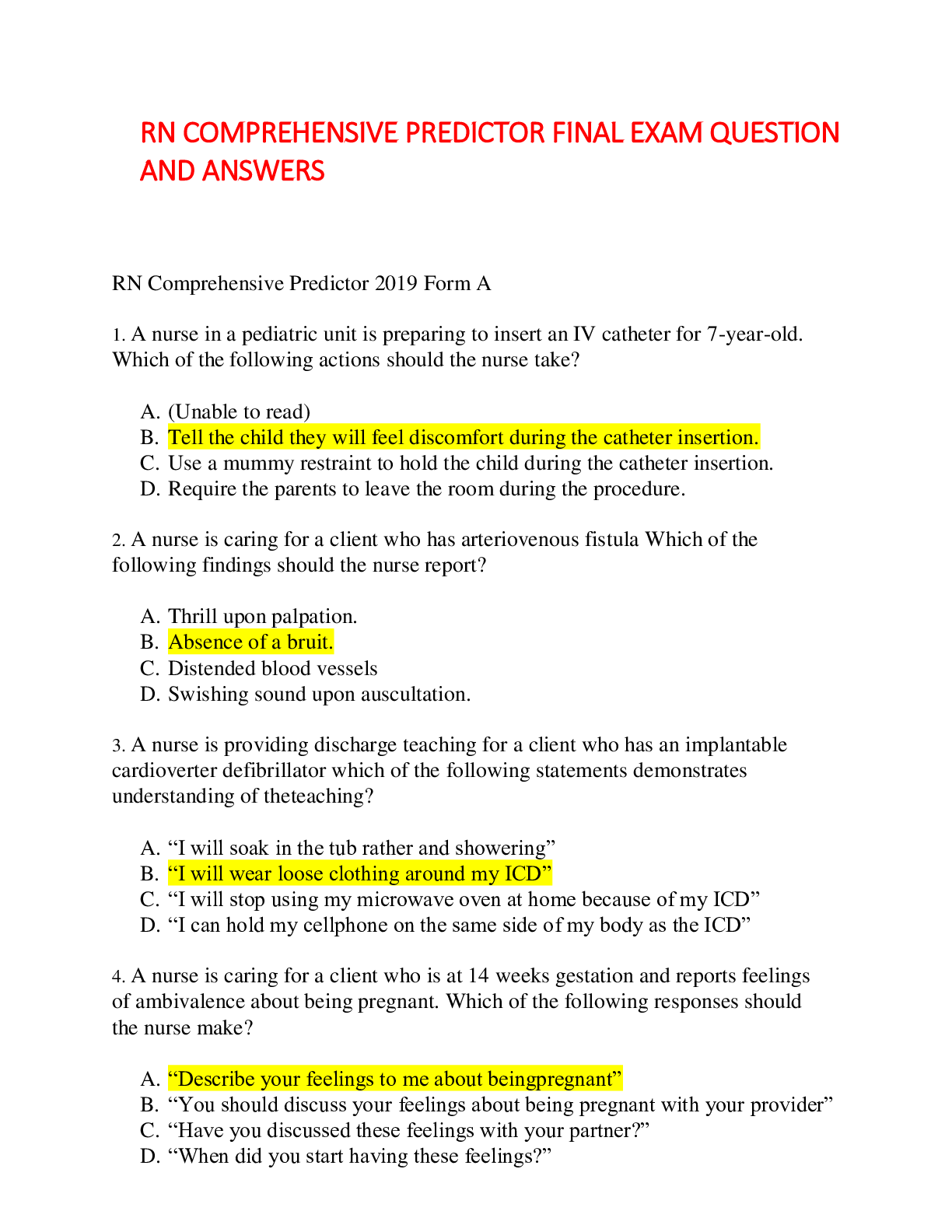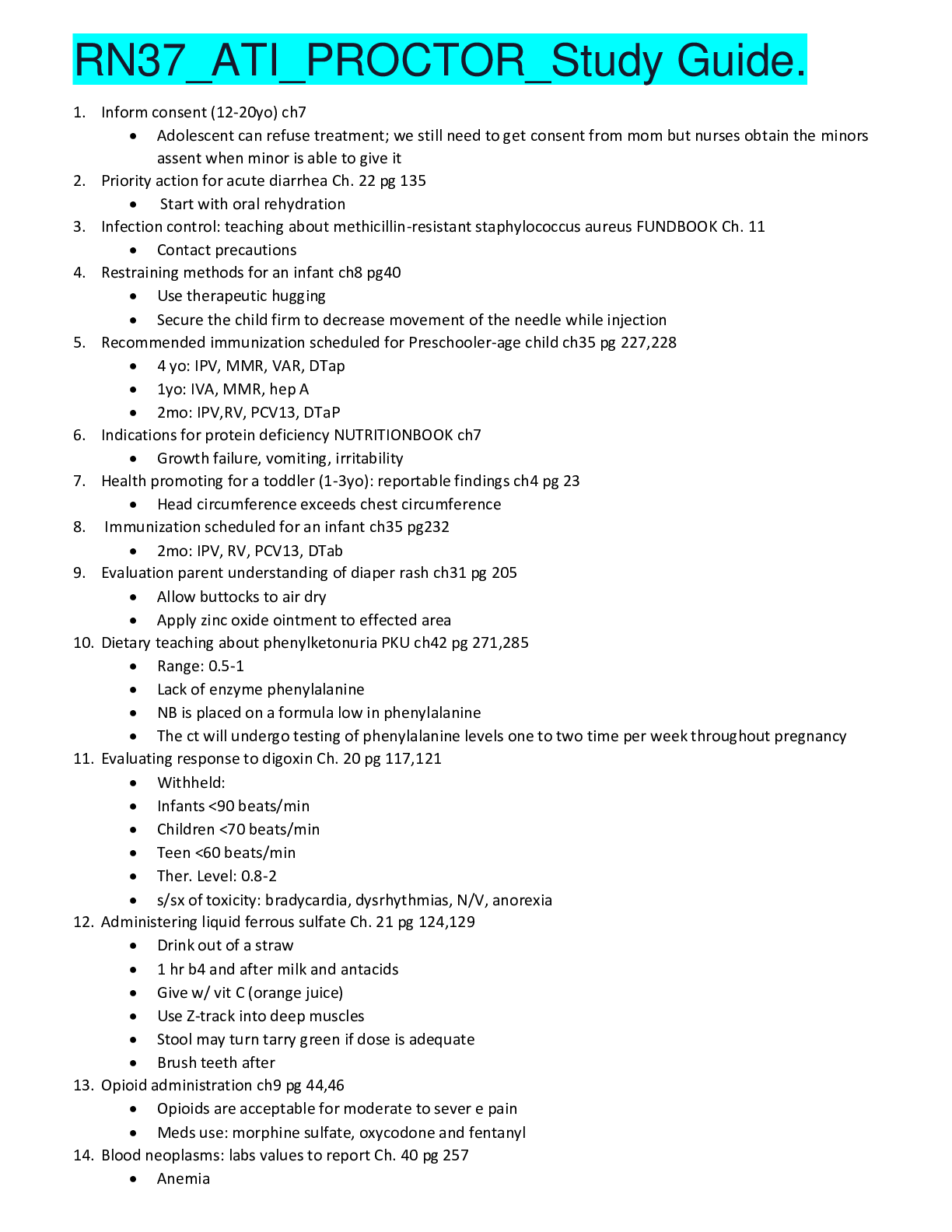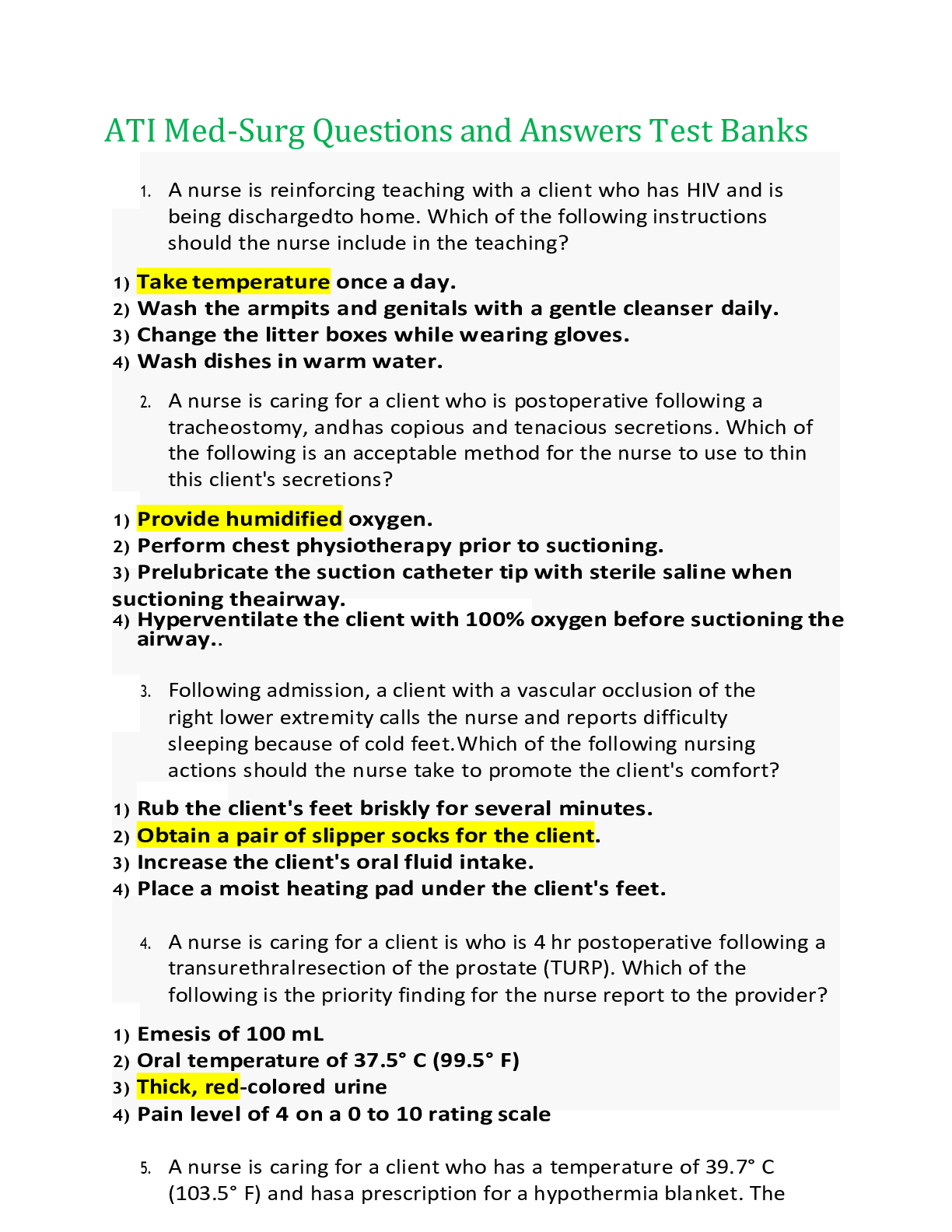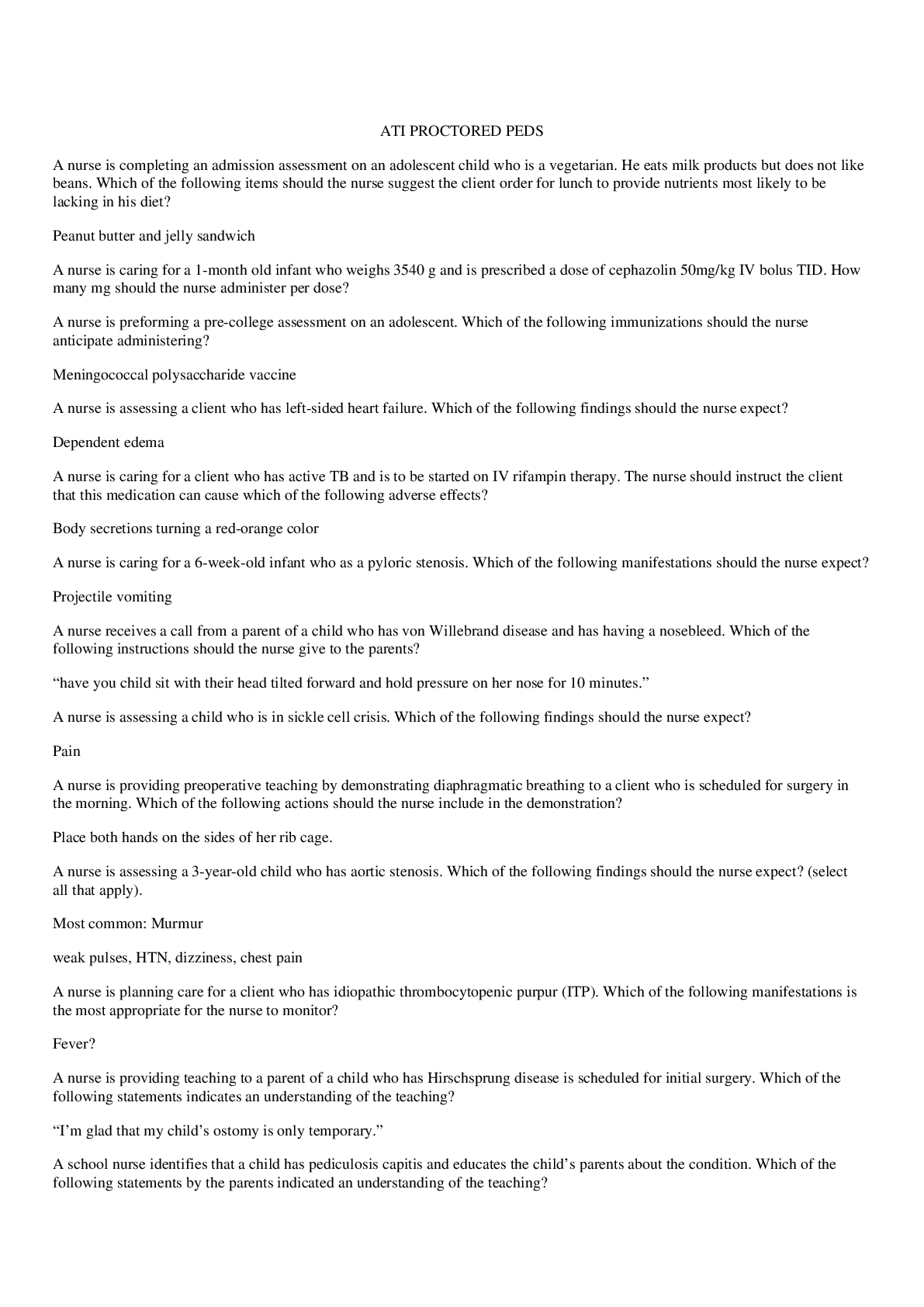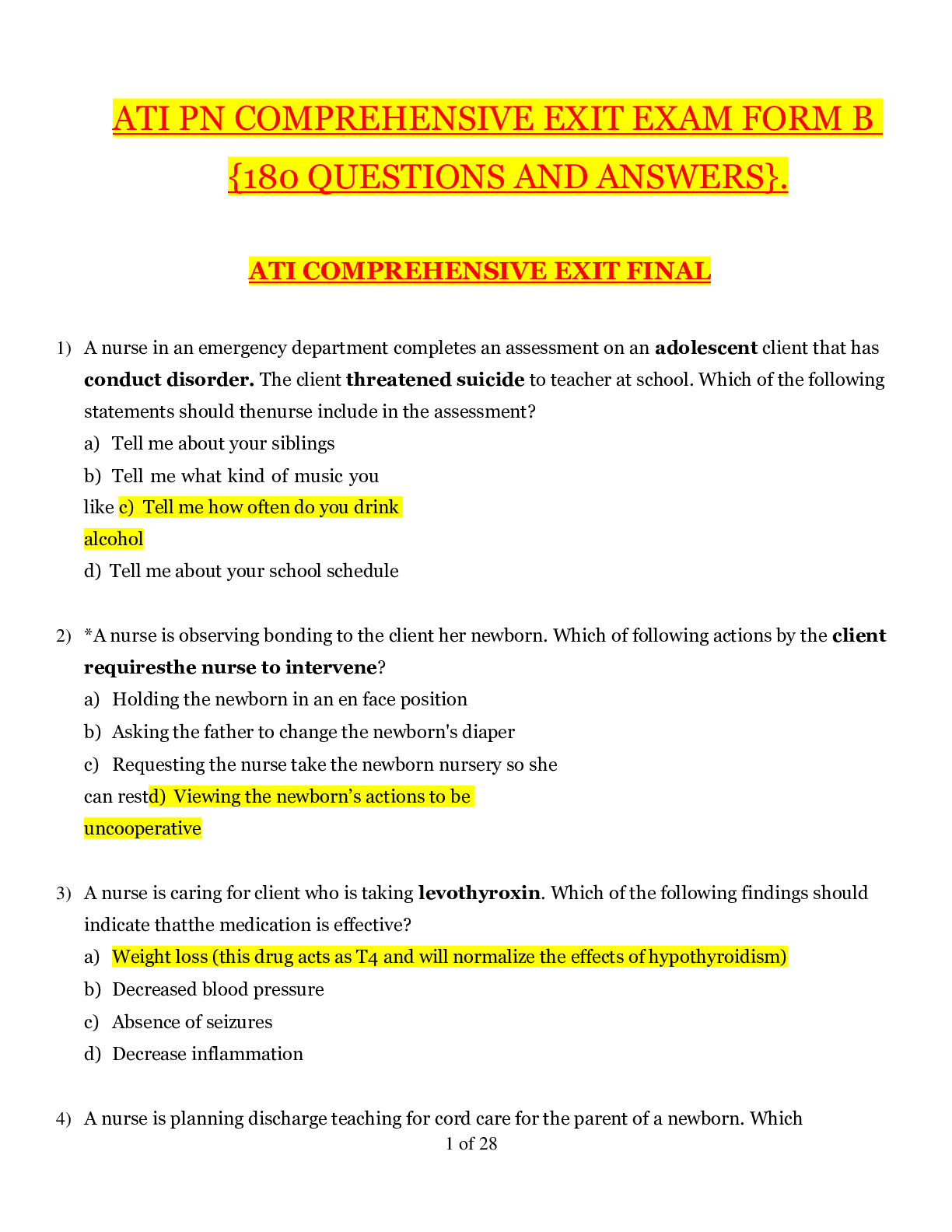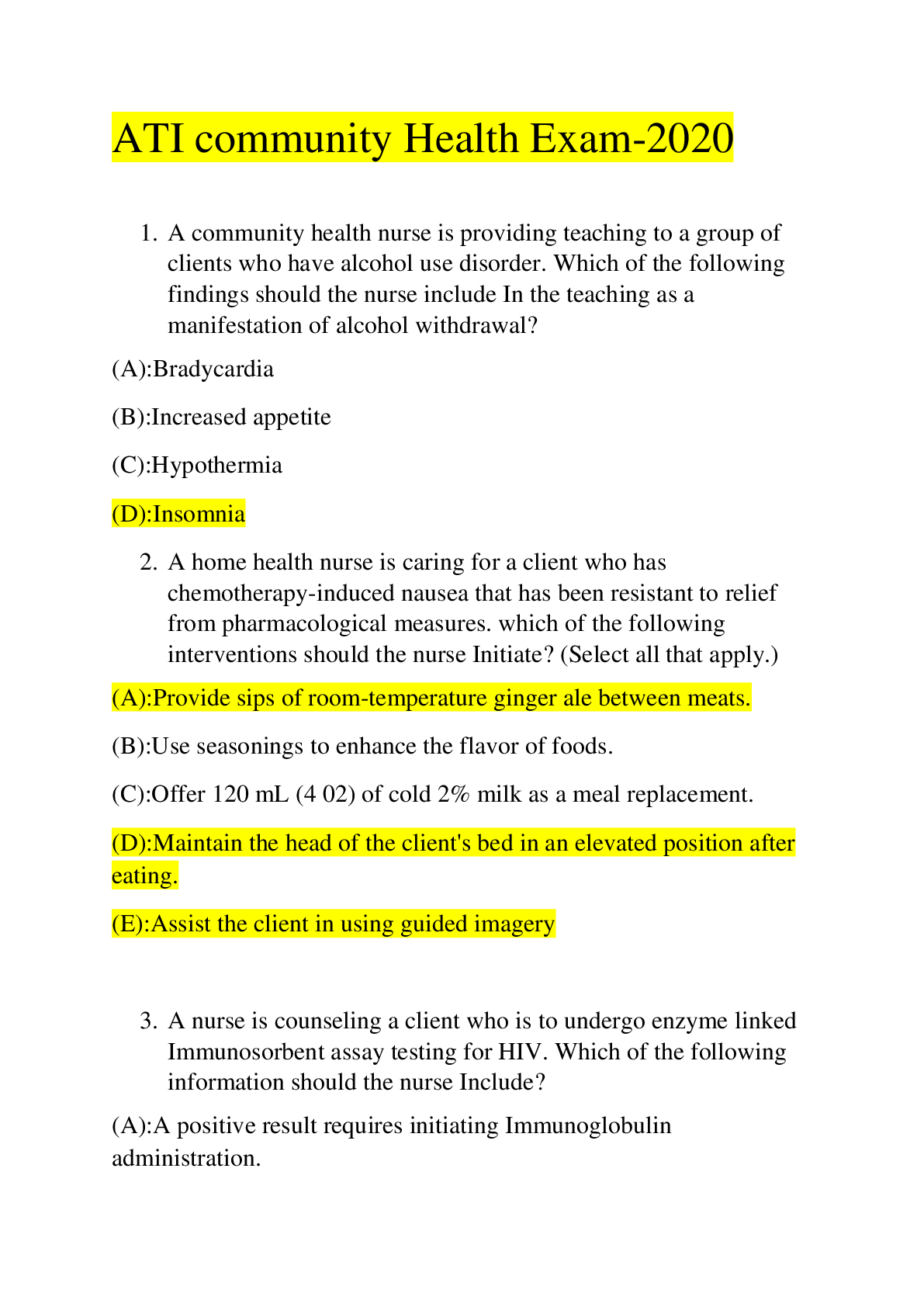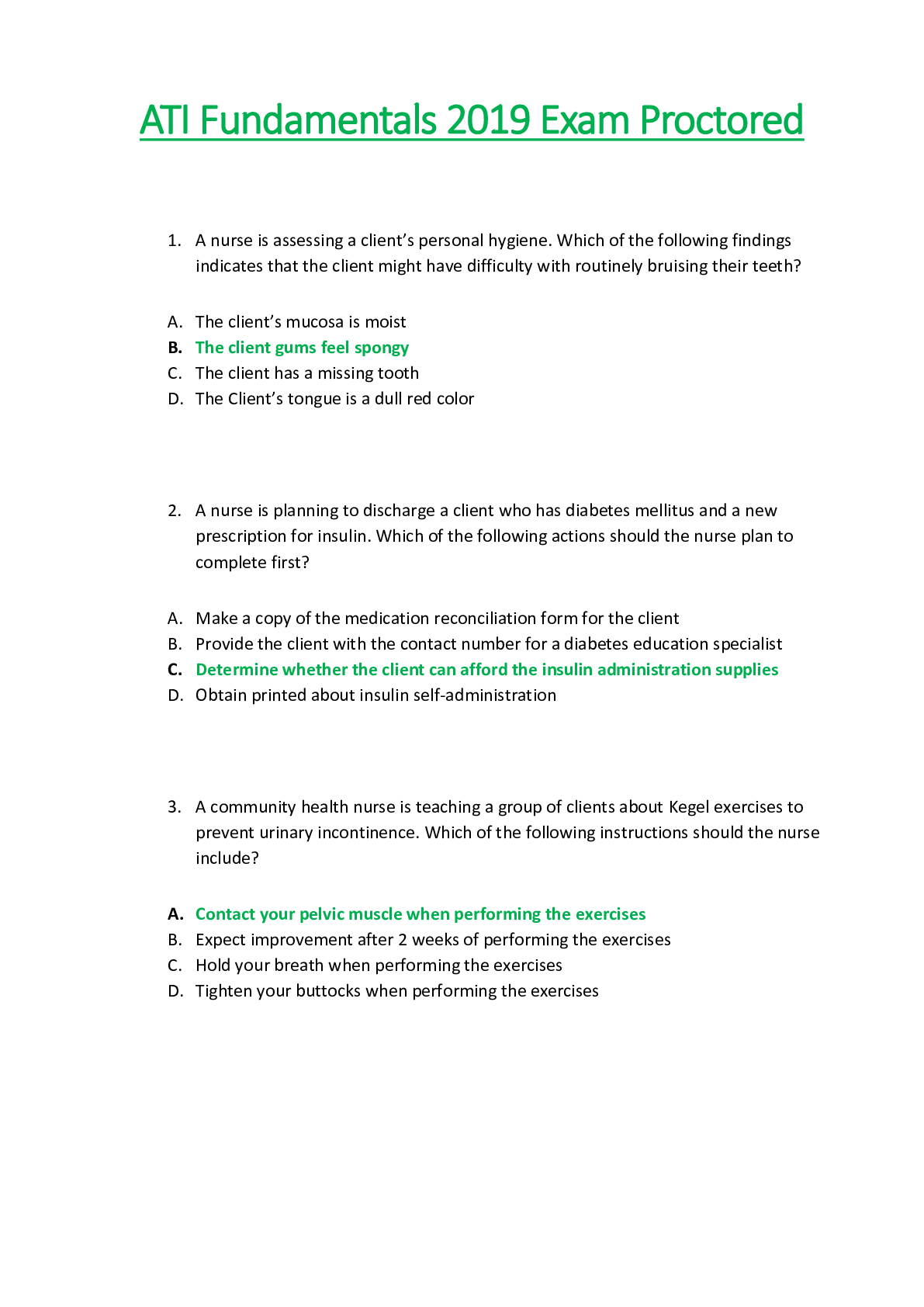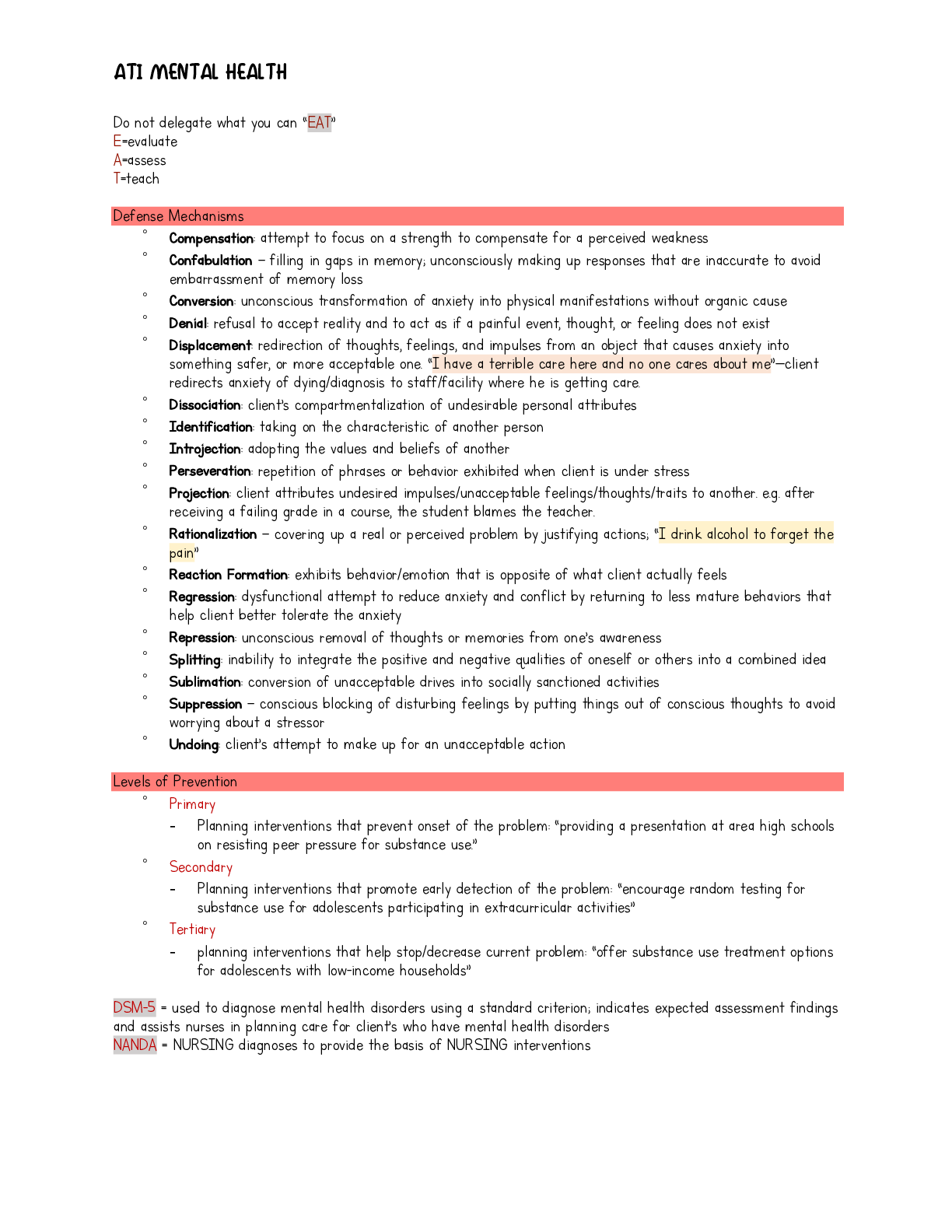*NURSING > EXAM PROCTORED > ATI NR 293 Pharmacology Final Review 1 Questions & Answers/rationale (All)
ATI NR 293 Pharmacology Final Review 1 Questions & Answers/rationale
Document Content and Description Below
NR293 ATI Pharmacology Final Review, Chamberlain College of Nursing 1. Calcium supplement for osteoporosis--why would they have flank pain 2. A nurse is preparing to administer a dose of lactulose to ... a client who has cirrhosis. The client states, "I don't need this medication. I am not constipated." The nurse should explain that in clients who have cirrhosis, lactulose is used to decrease levels of which of the following components in the bloodstream? a. Glucose b. Ammonia c. Potassium d. Bicarbonate 3. A nurse on a medical unit is planning care for an older adult client who takes several medications. Which of the following prescribed medications places the client at risk for orthostatic hypotension? (Select all that apply.) a. Furosemide b. Telmisartan c. Duloxetine d. Clopidogrel e. Atorvastatin 4. Someone has a-fib on coumadin, know what normal PT is 5. Someone is on atorvastatin (statin) what kind of labs do we look at 6. CKD nephrotoxicity 7. Heart failure and on Lasix, what are adverse effects of Lasix and what would happen if hypokalemic 8. Celecoxib for osteoarthritis (adverse effects??) 9. A nurse is caring for a client who has difficulty swallowing medications and is prescribed enteric-coated aspirin PO once daily. The client asks if the medication can be crushed to make it easier to swallow. Which of the following responses should the nurse provide? a. "Crushing the medication might cause you to have a stomachache or indigestion. b. "Crushing the medication is a good idea, and I can mix it in some ice cream for you.” c. "Crushing the medication would release all the medication at once, rather than over time." d. "Crushing is unsafe, as it destroys the ingredients in the medication." 10. A nurse is providing teaching for a client who is newly diagnosed with type 2 diabetes mellitus and has a prescription for glipizide. Which of the following statements by the nurse best describes the action of glipizide? a. "Glipizide absorbs the excess carbohydrates in your system." b. "Glipizide stimulates your pancreas to release insulin." . c. "Glipizide replaces insulin that is not being produced by your pancreas." d. "Glipizide prevents your liver from destroying your insulin." 11. Having transdermal analgesic-- look up emla cream 12. SAA--how to use cream with child ^^^ 13. A nurse is caring for a client who has active pulmonary tuberculosis (TB) and is to be started on intravenous rifampin therapy. The nurse should instruct the client that this medication can cause which of the following adverse effects? a. Constipation b. Black colored stools c. Staining of teeth d. Body secretions turning a red-orange color 14. A nurse is caring for a client who has congestive heart failure and is taking digoxin daily. The client refused breakfast and is complaining of nausea and weakness. Which of the following actions should the nurse take first? a. A. Check the client's vital signs. . b. Request a dietitian consult. c. Suggest that the client rests before eating the meal. d. Request an order for an antiemetic. 15. A nurse is caring for a client who has bipolar disorder and has been taking lithium for 1 year. Before administering the medication, the nurse should check to see that which of the following tests have been completed? a. Thyroid hormone assay b. Liver function tests: c. Erythrocyte sedimentation rate d. Brain natriuretic peptide 16. A nurse is caring for a client who has thrombophlebitis and is receiving heparin by continuous IV infusion. The client asks the nurse how long it will take for the heparin to dissolve the clot. Which of the following responses should the nurse give? a. "It usually takes heparin at least 2 to 3 days to reach a therapeutic blood level." b. "A pharmacist is the person to answer that question." c. "Heparin does not dissolve clots. It stops new clots from forming.". d. "The oral medication you will take after this IV will dissolve the clot. 17. Suspension --vigorously shake for 5 minutes , room temp 18. A nurse caring for a client who has hypertension and asks the nurse about a prescription for propranolol. The nurse should inform the client that this medication is contraindicated in clients who have a history of which of the following conditions? a) Asthma . b) Glaucoma c) Depression d) Migraines 19. A nurse is teaching a client who has a new prescription for colchicine to treat gout. Which of the following instructions should the nurse include? a. "Take this medication with food if nausea develops." b. B. "Monitor for muscle pain." c. "Expect to have increased bruising." d. "Increase your intake of grapefruit juice” 20. A nurse is teaching a client who has a urinary tract infection (UTI) and is taking ciprofloxacin. Which of the following instructions should the nurse give to the client? a. "If the medicine causes an upset stomach, take an antacid at the same time." b. "Limit your daily fluid intake while taking this medication." c. "This medication can cause photophobia, so be sure to wear sunglasses outdoors." d. "You should report any tendon discomfort you experience while taking this medication." 21. A nurse is teaching a client who has a urinary tract infection (UTI) and is taking ciprofloxacin. Which of the following instructions should the nurse give to the client? a. "If the medicine causes an upset stomach, take an antacid at the same time." b. "Limit your daily fluid intake while taking this medication." c. "This medication can cause photophobia, so be sure to wear sunglasses outdoors." d. "You should report any tendon discomfort you experience while taking this medication." 22. 17. A nurse is caring for a client who has cancer and a new prescription for ondansetron to treat chemotherapy-induced nausea. For which of the following adverse effects should the nurse monitor? a. Headache. b. Dependent edema c. Polyuria. d. Photosensitivity 23. A nurse is preparing to administer verapamil by IV bolus to a client who is having cardiac dysrhythmias. For which of the following adverse effects should the nurse monitor when giving this medication? a. Hyperthermia b. Hypotension . c. Ototoxicity d. Muscle pain 24. A nurse is providing teaching to a client who has renal failure and an elevated phosphorous level. The provider instructed the client to take aluminum hydroxide 300 mg PO three times daily. For which of the following adverse effects should the nurse inform the client? a. Constipation b. B. Metallic taste c. Headache d. Muscle spasms 25. A nurse is reviewing the medical record of a client who has been on levothyroxine for several months. Which of the following findings indicates a therapeutic response to the medication? a. Decrease in level of thyroxine (T4) b. Increase in weight c. Increase in hr of sleep per night d. Decrease in level of thyroid stimulating hormone (TSH). 26. A nurse is teaching a client who has been taking prednisone to treat asthma and has a new prescription to discontinue the medication. The nurse should explain to the client to reduce the dose gradually to prevent which of the following adverse effects? a. Hyperglycemia b. Adrenocortical insufficiency c. Severe dehydration d. Rebound pulmonary congestion 27. A nurse is teaching a client who has been taking prednisone to treat asthma and has a new prescription to discontinue the medication. The nurse should explain to the client to reduce the dose gradually to prevent which of the following adverse effects? a. Hyperglycemia b. Adrenocortical insufficiency Rationale: Prednisone, a corticosteroid, is similar to cortisol, the glucocorticoid hormone produced by the adrenal glands. It relieves inflammation and is used to treat certain forms of arthritis, severe allergies, autoimmune disorders, and asthma. Administration of glucocorticoids can suppress production of glucocorticoids, and an abrupt withdrawal of the drug can lead to a syndrome of adrenal insufficiency. c. Severe dehydration d. Rebound pulmonary congestion 28. A nurse is preparing a client for surgery. Prior to administering the prescribed hydroxyzine, the nurse should explain to the client that the medication is for which of the following indications? (Select all that apply.) a. Controlling emesis b. Diminishing anxiety c. Reducing the amount of narcotics needed for pain relief d. Preventing thrombus formation e. Drying secretions 29. A nurse is caring for a client who has acute respiratory distress syndrome (ARDS), and requires mechanical ventilation. The client receives a prescription for pancuronium. The nurse recognizes that this medication is for which of the following purposes? a. Decrease chest wall compliance b. Suppress respiratory effort c. Induce sedation d. Decrease respiratory secretions 30. Lisinopril (ace inhibitor) side effect 31. Poison ivy and give benadryl (side effects of ben) dry mouth? 32. A nurse is reviewing the medical record of a client who has been on levothyroxine for several months. Which of the following findings indicates a therapeutic response to the medication? a. Decrease in level of thyroxine (T4) b. Increase in weight c. Increase in hour of sleep per night d. Decrease in level of thyroid stimulating hormone (TSH). 33. A nurse on an oncology unit is preparing to administer doxorubicin to a client who has breast cancer. Prior to beginning the infusion, the nurse verifies the client's current cumulative lifetime dose of the medication. For which of the following reasons is this verification necessary? a. An excess amount of doxorubicin can lead to myelosuppression. b. Exceeding the lifetime cumulative dose limit of doxorubicin might cause extravasation. c. An excess amount of doxorubicin can lead to cardiomyopathy. d. Exceeding the lifetime cumulative dose limit of doxorubicin might produce red tinged urine and sweat. 34. A nurse at an ophthalmology clinic is providing teaching to a client who has open angle glaucoma and a new prescription for timolol eye drops. Which of the following instructions should the nurse provide? a. The medication is to be applied when the client is experiencing eye pain. b. The medication will be used until the client's intraocular pressure returns to normal. c. The medication should be applied on a regular schedule for the rest of the client's life. d. The medication is to be used for approximately 10 days, followed by a gradual tapering off. 35. Thympolin (like caffeine) 36. A nurse is caring for a client who is taking naproxen following an exacerbation of rheumatoid arthritis. Which of the following statements by the client requires further discussion by the nurse? a. "I signed up for a swimming class." b. "I've been taking an antacid to help with indigestion." c. "I've lost 2 pounds since my appointment 2 weeks ago." d. "The naproxen is easier to take when I crush it and put it in applesauce." 37. A nurse is performing discharge teaching for a client who has seizures and a new prescription for phenytoin. Which of the following statements by the client indicates a need for further teaching? a. "I will notify my doctor before taking any other medications." b. "I have made an appointment to see my dentist next week." c. "I know that I cannot switch brands of this medication." d. "I'll be glad when I can stop taking this medicine." 38. A nurse is providing discharge teaching to a client who has asthma and new prescriptions for cromolyn and albuterol, both by nebulizer. Which of the following statements by the client indicates an understanding of the teaching? a. “If my breathing begins to feel tight, I will use the cromolyn immediately.” b. “I will be sure to take the albuterol before taking the cromolyn.” c. “I will use both medications immediately after exercising.” d. “I will administer the medications 10 minutes apart.” Also hold breath for 10 seconds 39. A nurse is caring for a client who has heart failure and a prescription for digoxin. Which of the following statements by the client indicates an adverse effect of the medication? a. "I can walk a mile a day." b. "I've had a backache for several days." c. "I am urinating more frequently." d. "I feel nauseated and have no appetite." 40. A nurse is caring for a client who has HIV-1 infection and is prescribed zidovudine as part of antiretroviral therapy. The nurse should monitor the client for which of the following adverse effects of this medication? a. Cardiac dysrhythmia b. Metabolic alkalosis c. Renal failure d. Aplastic anemia 41. A nurse is caring for a client who has chronic renal disease and is receiving therapy with epoetin alfa. Which of the following laboratory results should the nurse review for an indication of a therapeutic effect of the medication? a. The leukocyte count b. The platelet count c. The hematocrit (Hct) d. The erythrocyte sedimentation rate (ESR) 42. A nurse is providing teaching for a client who is newly diagnosed with type 2 diabetes mellitus and has a prescription for glipizide. Which of the following statements by the nurse best describes the action of glipizide? a. "Glipizide absorbs the excess carbohydrates in your system." b. "Glipizide stimulates your pancreas to release insulin." . c. "Glipizide replaces insulin that is not being produced by your pancreas." d. "Glipizide prevents your liver from destroying your insulin.” 43. A nurse is caring for a client who is prescribed warfarin therapy for an artificial heart valve. Which of the following laboratory values should the nurse monitor for a therapeutic effect of warfarin? a. Hemoglobin b. Prothrombin time (PT) c. Bleeding time d. Activated partial thromboplastin time (aPTT) 44. A nurse in a critical care unit is caring for a client who is postoperative following a right pneumonectomy. After extubation from the ventilator, in which of the following positions should the client be placed? a. Prone b. On the nonoperative side c. Sims' d. Semi-Fowler's 45. A nurse in a coronary care unit is admitting a client who has had CPR following a cardiac arrest. The client is receiving lidocaine IV at 2 mg/min. When the client asks the nurse why he is receiving that medication, the nurse should explain that it has which of the following actions? a. Prevents dysrhythmias i. Rationale: Lidocaine is an antidysrhythmic medication that delays the conduction in the heart and reduces the automaticity of heart tissue. b. Slows intestinal motility c. Dissolves blood clots d. Relieves pain 46. A nurse is providing teaching for a client who has anemia and a new prescription for ferrous sulfate liquid. Which of the following instructions should the nurse provide? a. Take the medication on an empty stomach to decrease gastrointestinal irritation. b. Take the medication with orange juice to enhance absorption. c. Take the medication with milk. d. Rinse the mouth before taking the iron. 47. What instructions does nurse provide when administering mont 48. A nurse in a provider's clinic is assessing a client who has cancer and a prescription for methotrexate PO. Which of the following actions should the nurse take when the client reports bleeding gums? a. Explain to the client that this is an expected adverse effect. b. Check the value of the client's current platelet count. c. Instruct the client to use an electric toothbrush. d. Have the client make an appointment to see the dentist. 49. A nurse is teaching a client who has bipolar disorder and a prescription for lithium to recognize the manifestations of toxicity. Which of the following statements by the client indicates an understanding of the teaching? a. "I will report any loss of appetite." b. "Increased flatulence is an indication of toxicity." c. "Vomiting is an indication of toxicity." d. "I will call my provider if I experience any headaches." 50. Bacterial conjunctivitis, know to apply a. Thin line into the conjunctival sac 51. A nurse in a public clinic is planning a health fair for older adult clients in the community. In teaching medication safety, which of the following foods should the nurse advise the clients to avoid when taking their prescriptions? a. Carbonated beverage b. Milk c. OJ d. Grapefruit juice 52. Metachloprivide what is it for 53. A nurse is caring for a client who has developed gout. Which of the following medications should the nurse prepare to administer? a. Zolpidem b. Alprazolam c. Spironolactone d. Allopurinol 54. . A nurse is caring for a client who has diabetes insipidus and is receiving vasopressin. The nurse should identify which of the following findings as an indication that the medication is effective? a. A decrease in blood sugar b. A decrease in blood pressure c. A decrease in urine output d. A decrease in specific gravity 55. Schizophrenic on fluphenazine side effects a. Look up teaching too 56. A nurse on a medical unit is planning care for an older adult client who takes several medications. Which of the following prescribed medications places the client at risk for orthostatic hypotension? (Select all that apply.) a. Furosemide b. Telmisartan c. Duloxetine d. Clopidogrel e. Atorvastatin 57. A nurse is reviewing the health history for a client who has angina pectoris and a prescription for propranolol hydrochloride PO 40 mg twice daily. Which of the following findings in the history should the nurse report to the provider? a. The client has a history of hypothyroidism. b. The client has a history of bronchial asthma. c. The client has a history of hypertension. d. The client has a history of migraine headaches. 58. Ophthalmic ointment for pre-k age child w pink eye, what should nurse include in instructions a. Discard first few drops 59. Pt is on coumadin what would make you think they need further instruction a. Ginseng 60. A nurse is teaching a client about the adverse effects of cisplatin. Which of the following adverse effects should the nurse include in the teaching? a. Tinnitus b. Constipation c. Hyperkalemia d. Weight gain 61. nurse is caring for a client who is experiencing severe nausea and vomiting after a course of chemotherapy. The nurse should monitor the client for which of the following clinical manifestations? a. Metabolic acidosis b. Metabolic alkalosis c. Respiratory acidosis d. Respiratory alkalosis 62. A nurse is completing a medical interview with a client who has elevated cholesterol levels and takes warfarin. The nurse should recognize that which of the following actions by the client can potentiate the effects of warfarin? a. The client follows a low-fat diet to reduce cholesterol. b. The client drinks a glass of grapefruit juice every day. c. The client sprinkles flax seeds on food 1 hr before taking the anticoagulant. d. The client uses garlic to lower cholesterol levels. 63. A nurse is caring for a client who has a new prescription for ferrous sulfate tablets twice daily for iron-deficiency anemia. The client asks the nurse why the provider instructed that she take the ferrous sulfate between meals. Which of the following responses should the nurse make? a. "Taking the medication between meals will help you avoid becoming constipated." b. "Taking the medication with food increases the risk of esophagitis." c. "Taking the medication between meals will help you absorb the medication more efficiently." d. "The medication can cause nausea if taken with food." 64. A nurse is providing discharge teaching for a client who has a new prescription for warfarin. Which of the following instructions should the nurse include in the teaching? a. Mild nosebleeds are common during initial treatment. b. Use an electric razor while on this medication. i. Rationale: Warfarin, an anticoagulant, increases the client’s risk for bleeding. The nurse should teach the client safety measures, such as using an electric razor, to decrease the risk for injury and bleeding. c. If a dose of the medication is missed, double the dose at the next scheduled time. d. Increase fiber intake to reduce the adverse effect of constipation. 65. A nurse is preparing to initiate a transfusion of packed RBC for a client who has anemia. Which of the following actions should the plan to nurse take? a. Leave the client 5 min after beginning the transfusion. b. Infuse the transfusion at a rate of 200 mL/hr c. Check the client's vital signs every hour during the transfusion. d. Flush the blood tubing with dextrose 5% in water. 66. A charge nurse is supervising a newly licensed nurse care for a client who is receiving a transfusion of packed RBC. The nurse suspects a possible hemolytic reaction. After stopping the blood transfusion, which of the following actions by the new nurse requires intervention by the charge nurse? a. The nurse initiates an infusion of 0.9% sodium chloride. b. The nurse collects a urine specimen. c. The nurse sends a blood specimen to the laboratory. d. The nurse starts the transfusion of another unit of blood product.. 67. A nurse is educating a group of clients about the contraindications of warfarin therapy. Which of the following statements should the nurse include in the teaching? a. "Clients who have glaucoma should not take warfarin." b. "Clients who have rheumatoid arthritis should not take warfarin." c. "Clients who are pregnant should not take warfarin." . d. "Clients who have hyperthyroidism should not take warfarin." 68. A nurse is caring for a client who is receiving a transfusion of packed red blood cells and suspects that the client is experiencing a hemolytic reaction. Which of the following interventions is the priority? a. Collect a urine specimen. b. Administer 0.9% sodium chloride through the IV line. c. Stop the transfusion. . d. Notify the blood bank. 69. Fentatoyin (dilantin) a. flush w NS 70. A nurse is planning care for a client who has a detached retina and is preoperative for a surgical repair. The nurse should prepare to administer which of the following medications? a. Phenylephrine i. Mydriatic medications, such as phenylephrine, are used preoperatively to dilate pupils to facilitate intraocular surgery. b. Latanoprost c. Pilocarpine d. Timolol 71. A nurse is assessing a client who is receiving a parental lipid infusion. Which of the following findings is a manifestation of fat overload syndrome? a. Elevated temperature b. Hypertension c. Peripheral edema d. Erythema at the insertion site 72. A nurse is caring for a female client who has rheumatoid arthritis and asks the nurse if it is safe for her to take aspirin. The nurse should recognize which of the following findings in the client's history is a contraindication to this medication? a. Report of recent migraine headaches b. History of gastric ulcers . c. Current diagnosis of glaucoma d. Prior reports of amenorrhea 73. A nurse is teaching a client who has a new prescription for colesevelam to lower his low-density lipoprotein level. Which of the following instructions should the nurse include? a. "Take this medication 4 hr after other medications." . b. "Reduce fluid intake." c. "Take this medication on an empty stomach.” d. "Chew tablets before swallowing." 74. A nurse is assessing a client who is receiving dopamine IV to treat left ventricular failure. Which of the following findings should indicate to the nurse that the medication is having a therapeutic effect? a. Systolic blood pressure is increased . b. Cardiac output is reduced c. Apical heart rate is increased d. Urine output is reduced 75. A nurse is teaching a client who has diabetes mellitus and receives 25 units of NPH insulin every morning if her blood glucose level is above 200 mg/dL. Which of the following information should the nurse include? a. Discard the NPH solution if it appears cloudy. b. Shake the insulin vigorously before loading the syringe. c. Expect the NPH insulin to peak in 6 to 14 hr. d. Freeze unopened insulin vials. 76. Butorphanol why do we give to pt in labor, which should nurse have available to reverse med 77. A nurse is teaching a client who has a new prescription for fluoxetine to treat depression. Which of the following statements by the client indicates an understanding of the teaching? a. "I should expect to feel better after 24 hours of starting this medication." b. "I should not take this medicine with grapefruit juice." c. "I'll take this medicine with food." d. "I'll take this medicine first thing in the morning." 78. A nurse is instructing the parents of a client who has a new prescription for methylphenidate. Which of the following instructions should the nurse include? a. Avoid activities that require alertness such as driving. b. Increase caffeine intake. c. Take this medication before bedtime. d. Reduce calorie intake. 79. A nurse is teaching a client who has a new prescription for aluminum hydroxide to treat heartburn. The nurse should instruct the client to monitor for and report which of the following adverse reactions? a. Constipation b. Flatulence c. Palpitations d. Headache 80. Pancrelipase to aid digestion a. Makes pancreatic fluid thinner b. Nurse should inform client about which gastrointestinal changes 81. Drawing NPH and ___ in same syringe, what would you do if regular insulin looked cloudy a. Don’t use it 82. Dimenhydrinate side effects 83. A nurse in a substance abuse clinic is assessing a client who recently started taking disulfiram. The client reports having discontinued the medication after experiencing severe nausea and vomiting. Which of the following reasons should the nurse suspect to be a likely cause of the client's distress? a. The client demonstrated an allergic response to the medication. b. The client experienced a common side effect to the medication. c. The client consumed alcohol while taking the medication. d. The client took an overdose of the medication. 84. A nurse is reviewing the medication list for a client who has a new diagnosis of type 2 diabetes mellitus. The nurse should recognize which of the following medications can cause glucose intolerance? a. Ranitidine b. Guaifenesin c. Prednisone d. Atorvastatin 85. Someone taking alprazolam (xanax) for insomnia, which instructions should the nurse include a. Take at night? 86. A nurse in the emergency department is caring for a client who took 3 nitroglycerin tablets sublingually for chest pain. The client reports relief from the chest pain but now he is experiencing a headache. Which of the following statements should the nurse make? a. “A headache is is an indication of an allergy to the medication." b. “A headache is an expected adverse effect of this medication” c. “A headache indicates tolerance to this medication” d. “A headache is likely due to the anxiety about the chest pain” 87. Getting unit of packed red blood cells and had mild allergic reaction during previous transfusion, admin Benadryl to prevent a. Rash 88. 7.A nurse is preparing to administer nalbuphine to a postoperative client who is experiencing pain. The nurse should monitor the client for which of the following potential adverse effects of this medication? a. Miosis b. Joint pain c. Diarrhea d. Oliguria 89. Mydriatic eye drops what makes you think pt has systemic 90. MS has new prescription for diantaline, what makes you think pt gets instructions 91. Duodenal ulcer about new prescription of susmentadine --nurse includes which instructions a. Your HC provider might need to take thylopiline dose if on this med 92. A nurse is reviewing the laboratory results of a client who has liver failure with ascites and is receiving spironolactone. Which of the following findings should the nurse expect? a. Decreased sodium level b. Decreased phosphate level c. Decreased potassium level d. Decreased chloride level 93. Hip arthroplasty [Show More]
Last updated: 1 year ago
Preview 1 out of 15 pages
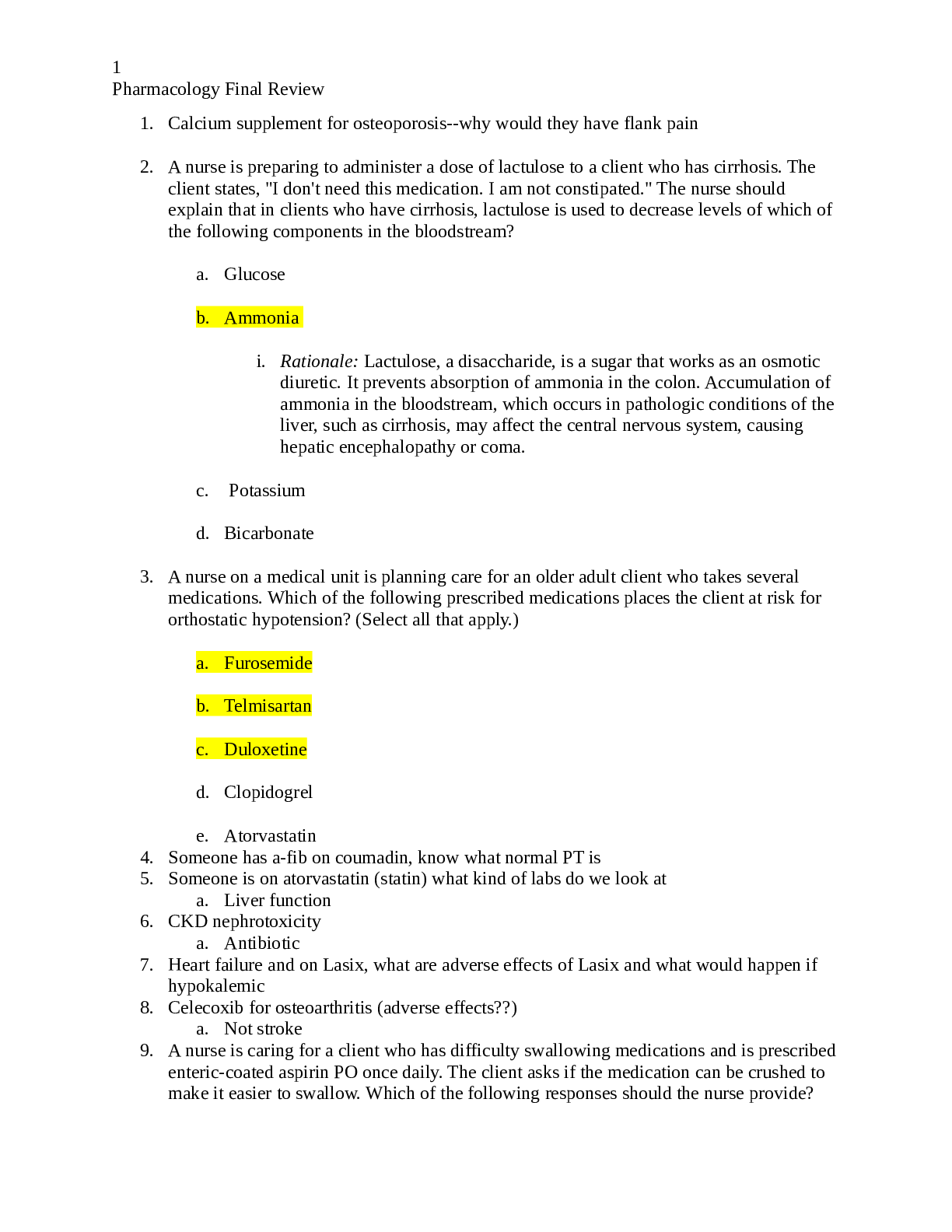
Reviews( 0 )
Document information
Connected school, study & course
About the document
Uploaded On
Dec 08, 2020
Number of pages
15
Written in
Additional information
This document has been written for:
Uploaded
Dec 08, 2020
Downloads
0
Views
32

